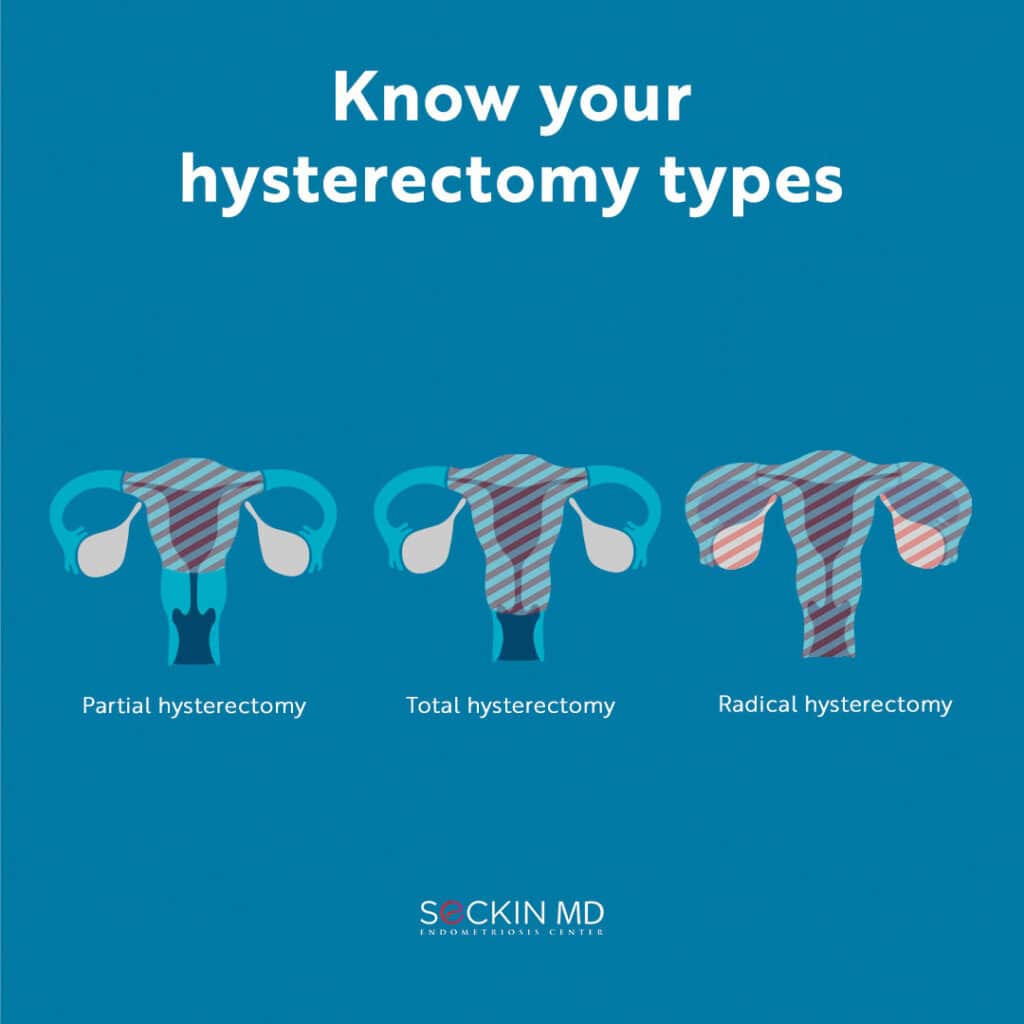Know your hysterectomy types

Hysterectomy refers to the surgical removal of the uterus. This technique results in surgical infertility and cessation of menstruation, so is typically offered when other treatment options have failed. But has your doctor talked to you about the different types of hysterectomy and their implications?
When is a hysterectomy performed?
Hysterectomies may be performed in cases of uterine fibroids, uterine prolapse, heavy bleeding, cancer, and hyperplasia. It is also the most common treatment option for adenomyosis in which endometriosis type lesions reside within the uterine wall. Endometriosis is where endometrial glands and stroma are outside of the uterus, most commonly on different parts of the pelvis and other extra-pelvic regions.
Statistics show that approximately 500,000 hysterectomies are performed each year and it is the second most common gynecologic procedure after Cesarean sections.
What are the different types of hysterectomies?
There are several types of hysterectomies and the appropriate choice comes after a thorough discussion with your doctor. Broadly, these include:
Partial hysterectomy
Also known as supracervical hysterectomy, the surgeon removes the uterus but not the cervix.
Total hysterectomy
This involves the complete removal of the uterus including the cervix. This can be an appropriate choice especially for women with a history of cervical dysplasia or abnormal pap smears.
Radical hysterectomy
Here, the surgeon removes the uterus, cervix, tissue around the cervix, and the top portion of the vagina. This may be necessary in certain types of cancer or extensive endometriosis.
In all hysterectomy types listed above, it is routine now to also remove bilateral fallopian tubes. Research has shown that this decreases the future risk of certain types of ovarian cancer.
Total hysterectomy with bilateral salpingo-oophorectomy
Here the surgeon removes both the ovaries and the fallopian tubes along with the uterus and cervix. This procedure results in surgical menopause. Patients may feel the immediate effects of menopause such as hot flashes, night sweats, vaginal dryness, and mood changes. Some of these effects may improve with hormonal therapy. Removal of ovaries can be necessary in cancer, cancer risk reduction and/or severe endometriosis.
How is it performed?
There are also different ways to perform a hysterectomy.
Vaginal hysterectomy
Here, the surgeon removes the uterus through a vaginal incision without any external opening. Recovery is fast with the least complications, and you can usually go home the day of the surgery. These are appropriate for women without many surgeries, small uteruses, and no suspicion for endometriosis or diseases of the adnexa (fallopian tubes/ ovaries).
Laparoscopic hysterectomy
Here, the surgeon makes small incisions into the abdomen through which they insert a camera and instruments. They inflate the abdomen with gas and they stand by the patient throughout the surgery. You can usually go home the same day or after a night’s rest in the hospital after this procedure.
Robotic-assisted laparoscopic hysterectomy
This is similar to a laparoscopic hysterectomy except that the surgeon takes the help of a robotic machine for more precision. Incision placement and/or size can be slightly different.
Abdominal (open) hysterectomy
This involves a six- to eight-inch long incision in the abdomen to completely remove the uterus. This procedure is less common now as it is associated with longer recovery times, longer period of hospitalization, and more complications. It may be necessary for enlarged fibroids.
How is the recovery process after a hysterectomy?
The duration of hospitalization and recovery process largely depends on the type of hysterectomy. In general, it can take anywhere between four to six weeks for a full recovery.
During recovery, your doctor will likely tell you to avoid lifting weights, excessive exercise, and sexual intercourse. Mild discomfort, postoperative pain, and light vaginal bleeding can be normal for a period after surgery. You may also have scarring, redness, and itching near the incision site. Laparoscopic procedures can reduce some of these symptoms.
If you’ve also had your ovaries removed, you may experience mood swings, hot flashes, and other menopausal symptoms.
One thing to be aware of is that hysterectomy does not affect sex life or the ability to orgasm.
So will you have a hysterectomy?
The exact hysterectomy type and procedure is the outcome of a conversation with your doctor and often your family as well. You should weigh the risks and benefits and understand that you will no longer be able to become pregnant after a hysterectomy.
Although many doctors continue to prescribe hysterectomy as first line treatment for endometriosis, we at Seckin Endometriosis Center advocate this only if there are no other options and after we completely remove all endometriosis lesions via laparoscopic deep excision surgery together with our in-house techniques of Aqua Blue Contrast visualization and cold excision. This results in longer symptom relief and preserved fertility if that is our patient’s desire.
Did you know you had different options when it comes to hysterectomy? Please do not hesitate to share your thoughts by leaving a comment on our post on Facebook or Instagram.
Get a Second Opinion
Our endometriosis specialists are dedicated to providing patients with expert care. Whether you have been diagnosed or are looking to find a doctor, they are ready to help.Our office is located on 872 Fifth Avenue New York, NY 10065.
You may call us at (646) 960-3080 or have your case reviewed by clicking here.